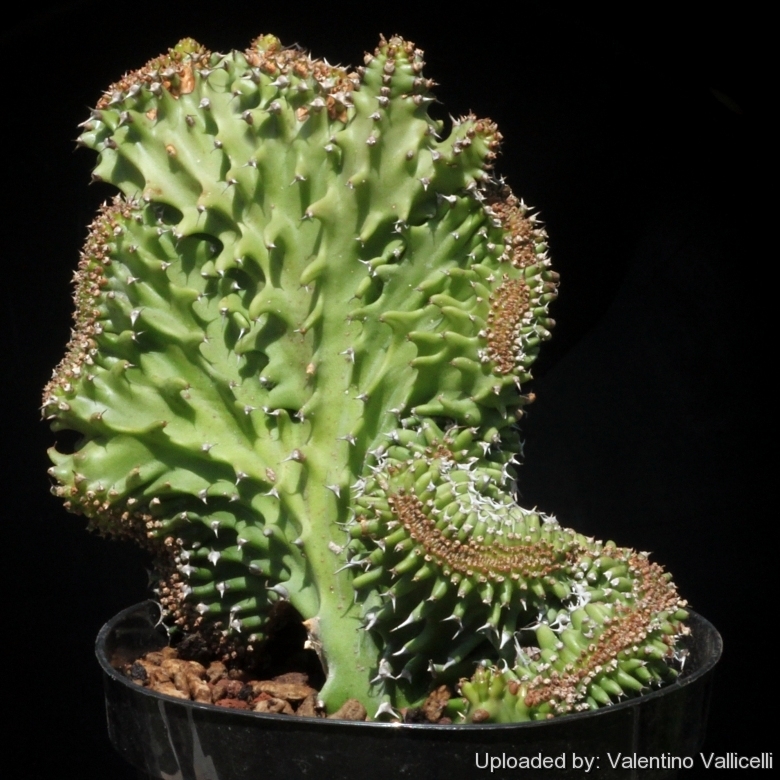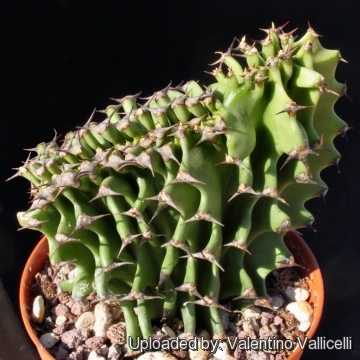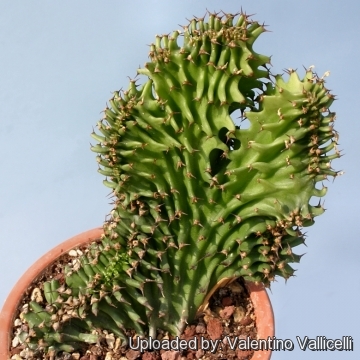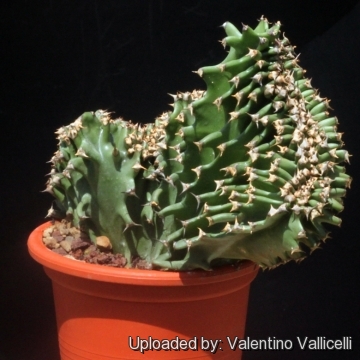
Euphorbia erythraeae f. monstruosa cristata Photo by: Valentino Vallicelli
Origin and Habitat: Garden origin (Nursery produced cultivar)
Synonyms:
See all synonyms of Euphorbia erythraeae
Common Names include:
ENGLISH: Crested Candelabra Spurge
Description: The typical Euphorbia erythraea is a typical representative of large, tree-like candebra Euphorbias that can grow up to 10 (or more) m tall (with a short trunk up to 90 cm in diameter) and superficially similar to some new world Cacti with a deep green, clean and smooth epidermis.
The monstrous and crested form here described is a strange plant that produces both intricately undulating fan-shaped and monstrous branches on the same plant, in fact the two growing forms are reversible.
Remarks: It’s one of the more poisonous spurges. The latex which is very bitter and acrid contains diterpenes and is considered highly toxic.
Subspecies, varieties, forms and cultivars of plants belonging to the Euphorbia abyssinica group
 Euphorbia erythraeae f. monstruosa cristata Photo by: Valentino Vallicelli
Euphorbia erythraeae f. monstruosa cristata Photo by: Valentino Vallicelli - Where a potted plant with a strong sculptural quality is required this Euphorbia is the right one. Photo by: Valentino Vallicelli
- Where a potted plant with a strong sculptural quality is required this Euphorbia is the right one. Photo by: Valentino Vallicelli Euphorbia erythraeae f. monstruosa cristata Photo by: Valentino Vallicelli
Euphorbia erythraeae f. monstruosa cristata Photo by: Valentino VallicelliSend a photo of this plant.The gallery now contains thousands of pictures, however it is possible to do even more. We are, of course, seeking photos of species not yet shown in the gallery but not only that, we are also looking for better pictures than those already present.
Read More... Cultivation and Propagation: Euphorbia erythraea is an easy species to grow that is suited for any well drained soil in full sun. But young plant are happy growing indoors, where they can easily reach the ceiling. Give the plant an airy growing medium which mainly consists of non organic material such us clay, pumice, lava grit, and only a little peat or leaf-mould. Water regularly during the active growing season from March to September. No water should ever be allowed to stand around the roots. Keep almost completely dry in winter. It is a moderately fast grower, and will quickly become large landscape masterpieces in just 3-5 years. Only downside is from strong winds, the columns often smash into each other, causing permanent scarring... best to plant in such a location where winds are not a big issue. If plant becomes very red, this is a sign that the roots have not developed properly. It is a relatively fast growing and long lived plant and once established, it will be content in its position and with its soil for years. It can tolerate moderate shade, and a plant that has been growing in shade should be slowly hardened off before placing it in full sun as the plant will be severely scorched if moved too suddenly from shade into sun. Like quite small pots, repott in very later winter, early spring. Can be pruned for shape and branching. Frost tender, frost free zones only.
Specific tips for growing the crested forms: The crests are sometime grafted onto the standard columnar form but are easily grown on their own roots. Any normal shoots should be removed to promote the growth of the crest.
Propagation: Grafting or cuttings. It is easy to propagate by cuttings in late spring to summer, just take a cutting of the plant let it dry for 1 or 2 weeks and stuff it in the ground (preferably dry, loose, extremely well draining soil). Cuttings will root only in hot weather. Cuttings must be kept quite dry to root.













